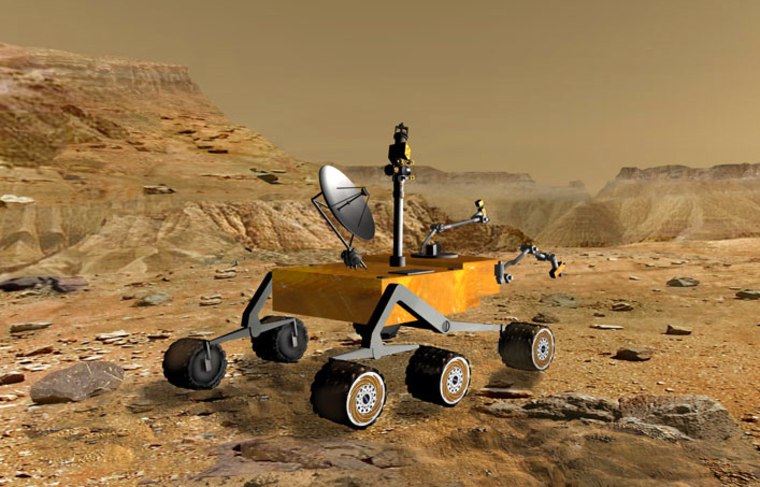NASA’s nuclear future promises more maneuverable, longer-lasting spacecraft and rovers with more onboard power than scientists know what to do with.
Nuclear propulsion and power systems also could greatly reduce travel times to distant planets and supply energy to future planetary settlements, said Al Newhouse, director of NASA’s Project Prometheus nuclear power and propulsion program.
In the near term, Newhouse said, NASA’s nuclear ambitions are focused on building a better battery for an unmanned lander launching to Mars in 2009 and a nuclear-electric propulsion system for a planned 2015 robotic tour of Jupiter’s icy moons. NASA plans to spend more than $480 million in 2005 to continue work begun last year on a new generation of radioisotope power generators as well as nuclear-electric propulsion systems capable of producing thrust over long periods of time.
Competing battery designs
Boeing Co. and Lockheed Martin Corp. are working on competing nuclear battery designs for NASA’s 2009 Mars Science Laboratory and other missions in the early planning stages.
Boeing’s Canoga Park, Calif.-based Rocketdyne Propulsion and Power unit is designing a so-called Multi-Mission Radioisotope Thermoelectric Generator, a more powerful version of the radioisotope thermoelectric generators that powered NASA’s Viking 1 and 2 Mars landers in the 1970s. While the Multi-Mission RTG would not be as powerful as the RTGs aboard NASA’s Cassini Saturn probe, it is designed to be more flexible, adaptable to both the orbiter and lander missions on the space agency’s drawing boards.
Lockheed Martin is working on a new type of system called a Stirling Radioisotope Generator. Like RTGs, the Stirling system would convert heat from decaying plutonium into electricity.
Where the two approaches differ is that the Stirling system has moving parts — vibrating pistons that make much more efficient use of the rare and costly plutonium-238. The potential drawback of such systems is that their moving parts could cause interference problems for spacecraft instruments.
Jim Crocker, vice president of civil space at Lockheed Martin Space Systems of Denver, said the company is making progress addressing the concerns that normally greet new technology.
"It will take a while for people to give [the Stirling generator] a fair shake, but in the end, it will win out," Crocker said.
Both designs to be developed
Regardless of which system it picks for the Mars Science Laboratory, NASA intends to fully develop both designs, according to Joe Naninger, head of nuclear power and propulsion research at NASA’s Glenn Research Center in Cleveland. Although Glenn has a major role in the Stirling project, Naninger admits that Boeing’s evolutionary approach might have an edge in the Mars Science Laboratory competition.
"There may not be enough confidence in the Stirling system yet," Naninger said. "The [Multi-Mission] RTG is based on known technology." Naninger added, however, that the Stirling system "promises fourfold improvement in efficiency, which means it can generate the same power levels with one-fourth the plutonium."
The U.S. Department of Energy is taking steps to resume U.S. production of the non-weapons-grade plutonium that it currently buys from Russia. Naninger said that even with larger inventories of plutonium-238 on hand, making efficient use of the material will remain important as a means of keeping spacecraft weight down.
Reactors for space
Looking farther into the future, NASA, with the help of the Energy Department, is hard at work on the nuclear power system needed for the Jupiter Icy Moons Orbiter’s planned 10- to 15-year mission to explore the largest planet in the solar system and three of its moons. The Energy Department, working with industry, is designing a space-qualified nuclear fission reactor capable of generating 100 kilowatts of power — about 1,000 times more than most solar-powered space probes have available today.
Lockheed Martin’s Crocker said one of the big challenges for scientists will be coming up with new ways to use all that additional power.
"The biggest advantage to having large amounts of power is that you can go from passive instruments" such as cameras and spectrographs "to active instruments" like ice-penetrating radar, Crocker said. "More power also translates into more bandwidth, so we can expect to get larger amounts of data back."
The uranium-fueled reactor also would power the electric propulsion system that will enable the spacecraft to reach Jupiter in a relatively short time and then maneuver in and out of orbit around the gas giant and its moons.
Two competing thruster designs are in development at Glenn and the Jet Propulsion Laboratory in Pasadena, Calif. The Jet Propulsion Laboratory’s thruster, a next-generation version of the non-nuclear xenon-ion propulsion system on NASA’s experimental Deep Space 1 spacecraft, has already operated at its 25-kilowatt target level. Glenn’s High Power Electric Propulsion thruster — HiPEP for short — operated at 12.5 kilowatts in November and expects to reach 25 kilowatts of power handling by March, according to Naninger.
Either system would have to be scaled up to handle the power input NASA wants for the Jupiter Icy Moons Orbiter and other deep-space exploration missions.
